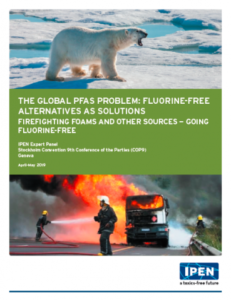From 17th to 21st of September 2018, FAO – Food and Agriculture Organization of the United Nations – debated about the future of several POP – Persistent Organic Chemicals.
3F attended the event as part of the IPEN Panel – International POPS Elimination Network – in order to expose its views to the UN Members, over the manufacturing and use of a family of fluorochemicals currently used in fire-fighting foams and other applications.
The focus was on PFOS, PFHxS and PFOA, their precursors and derivatives. These compounds have been commonly used and are still used in the fire-fighting foams, to enhance the performance of the foam over liquid fires. The most well-known of these foams and most commonly used is Aqueous Film-Forming Foam better known as AFFF.
It was acknowledged by the Committee that all this group of chemicals area categorized as POPs, and are characterized by their High Persistency, Bioaccumulative and Toxic profile. They are found to travel worldwide via the oceans and atmosphere and found their way to remote places such as Artic and Antarctic areas.
A draft was issued at the end of the week, which draws a deadline to the manufacture and use of these chemicals.
To summarize the text:
”… the transitioning to the use of short-chain per- and polyfluoroalkyl substances (PFASs) for dispersive applications such as fire-fighting foams is not a suitable option from an environmental and health point of view and that some time to move to alternatives without PFASs may be needed”
”…3. Recommends to the Conference of the Parties that it consider encouraging Parties not to replace fire-fighting foam that contain or may contain PFOA, its salts and PFOA-related compounds with short-chain PFASs due to their persistency and mobility as well as potential negative environmental, health and socio-economic impacts.”
That means there is a recommendation to move away from actual AFFF to Fluor Free Foams because fire-fighting foams are used in a highly dispersive use threatening environment and health.
Other Fluoro compounds – such as C6 – are persistent and mobile and should not be considered as a safe option for environmental, health and socio economic impacts.
Notes relating to fire-fighting foams with PFOA, PFOS or PFHxS.
- These foams cannot be imported or exported if NOT for proper recognized disposal
- They cannot be used for training or testing
- By the end of 2022, they cannot be used if not properly bunded for collection
- All effluents must be collected, so they cannot be used for dispersive applications (referring to NO possible collection of foam uses at sea / river / land)
- Foam stocks must be eliminated by incineration or other recognized safe disposal method
If you need more information, you can contact us and we will assist or direct you to other bodies which can provide support for assistance.


 – Reduction of the COD/BOD for a better degradation,
– Reduction of the COD/BOD for a better degradation,
